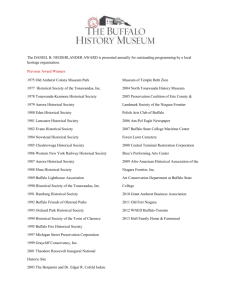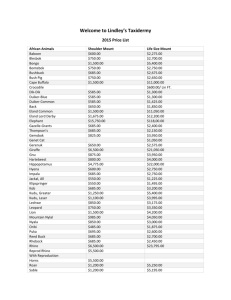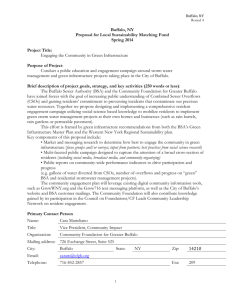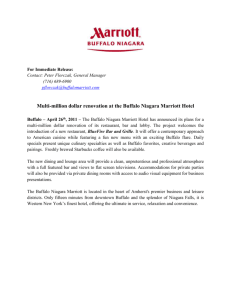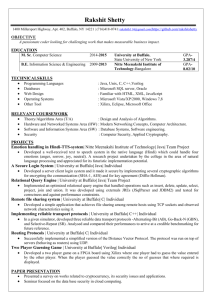The Great Granite Plateau (accessible version)
advertisement
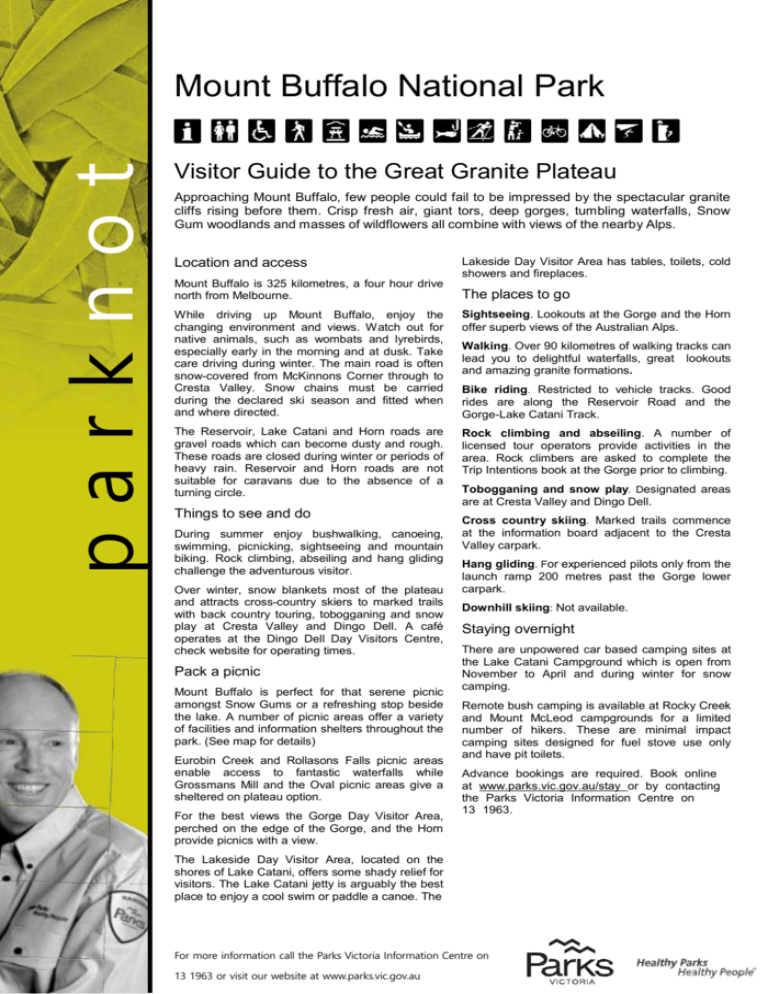
parknot es Mount Buffalo National Park Visitor Guide to the Great Granite Plateau Approaching Mount Buffalo, few people could fail to be impressed by the spectacular granite cliffs rising before them. Crisp fresh air, giant tors, deep gorges, tumbling waterfalls, Snow Gum woodlands and masses of wildflowers all combine with views of the nearby Alps. Location and access Lakeside Day Visitor Area has tables, toilets, cold showers and fireplaces. Mount Buffalo is 325 kilometres, a four hour drive north from Melbourne. The places to go While driving up Mount Buffalo, enjoy the changing environment and views. Watch out for native animals, such as wombats and lyrebirds, especially early in the morning and at dusk. Take care driving during winter. The main road is often snow-covered from McKinnons Corner through to Cresta Valley. Snow chains must be carried during the declared ski season and fitted when and where directed. Sightseeing. Lookouts at the Gorge and the Horn offer superb views of the Australian Alps. The Reservoir, Lake Catani and Horn roads are gravel roads which can become dusty and rough. These roads are closed during winter or periods of heavy rain. Reservoir and Horn roads are not suitable for caravans due to the absence of a turning circle. Rock climbing and abseiling. A number of licensed tour operators provide activities in the area. Rock climbers are asked to complete the Trip Intentions book at the Gorge prior to climbing. Things to see and do During summer enjoy bushwalking, canoeing, swimming, picnicking, sightseeing and mountain biking. Rock climbing, abseiling and hang gliding challenge the adventurous visitor. Over winter, snow blankets most of the plateau and attracts cross-country skiers to marked trails with back country touring, tobogganing and snow play at Cresta Valley and Dingo Dell. A café operates at the Dingo Dell Day Visitors Centre, check website for operating times. Pack a picnic Mount Buffalo is perfect for that serene picnic amongst Snow Gums or a refreshing stop beside the lake. A number of picnic areas offer a variety of facilities and information shelters throughout the park. (See map for details) Eurobin Creek and Rollasons Falls picnic areas enable access to fantastic waterfalls while Grossmans Mill and the Oval picnic areas give a sheltered on plateau option. For the best views the Gorge Day Visitor Area, perched on the edge of the Gorge, and the Horn provide picnics with a view. Walking. Over 90 kilometres of walking tracks can lead you to delightful waterfalls, great lookouts and amazing granite formations. Bike riding. Restricted to vehicle tracks. Good rides are along the Reservoir Road and the Gorge-Lake Catani Track. Tobogganing and snow play. Designated areas are at Cresta Valley and Dingo Dell. Cross country skiing. Marked trails commence at the information board adjacent to the Cresta Valley carpark. Hang gliding. For experienced pilots only from the launch ramp 200 metres past the Gorge lower carpark. Downhill skiing: Not available. Staying overnight There are unpowered car based camping sites at the Lake Catani Campground which is open from November to April and during winter for snow camping. Remote bush camping is available at Rocky Creek and Mount McLeod campgrounds for a limited number of hikers. These are minimal impact camping sites designed for fuel stove use only and have pit toilets. Advance bookings are required. Book online at www.parks.vic.gov.au/stay or by contacting the Parks Victoria Information Centre on 13 1963. The Lakeside Day Visitor Area, located on the shores of Lake Catani, offers some shady relief for visitors. The Lake Catani jetty is arguably the best place to enjoy a cool swim or paddle a canoe. The For more information call the Parks Victoria Information Centre on 13 1963 or visit our website at www.parks.vic.gov.au For further information Parks Victoria Information Centre Call 13 1963 or visit our website at www.parks.vic.gov.au Camping permits and track information Mount Buffalo Park Office PO Box 20 Bright VIC 3741 Phone: 13 1963 Relevant maps Mount Buffalo Plateau 1:30,000 topographic by Geoff Lawford Eurobin & Buckland 1:25,000 topographic from Vic Map Relevant codes / guides Bushwalking Code Car Camping Code Bush Camping Code Mount Buffalo Visitor Guide Alps in Flower Field Guide Caring for the environment Help us look after your park by following these guidelines: Please take rubbish home with you for recycling & disposal All native plants, animals and landforms are protected Dogs, cats and other pets are prohibited within the park Firearms are also prohibited Camping is permitted only in the designated areas Fires are permitted only in fireplaces provided and must be attended at all times whilst going. Hot coals are considered a ‘going fire’ The making of a mountain A classic national park Massive as the mountain now is, it was once three times its present height. Originally this area was covered with sedimentary rock laid down by the sea. The fantastically shaped boulders and tors were further shaped by heat, wind, plants, water and ice attacking joints in the granite, widening cracks, forming soil and giving this park its unique and spectacular landscape. The Bright Alpine Club actively lobbied the government to protect the area. Subsequently 1,152 ha surrounding the Gorge was declared a national park in 1898, becoming (with Wilson’s Promontory) one of Victoria’s first national parks. A natural island in the sky The plateau’s isolation, harsh alpine climate and range of altitudes have resulted in a rich array of plants and animals. Some plants such as Buffalo Sallee, Buffalo Sallow Wattle and Fern-leaf Baeckea are found nowhere else in the world. Dry foothill forests, tall wet mountain forests, Snow Gum woodlands, alpine heathlands, Sphagnum Moss beds, Snow-grass plains and wildflowers can all be found along the main road and on tracks throughout the park. Look for Crimson Rosellas and Gang-gang Cockatoos feeding in the tree tops. Superb Lyrebirds are often seen scratching in the leaf litter. If you walk quietly, Wombats, Swamp Wallabies and Brown Antechinus may be visible, as well as a variety of snakes and lizards. At night Greater Gliders, Tawny Frogmouths and Eastern Pygmy Possums are active. Some animals are quite common while others, like the critically endangered Spotted Tree Frog, are rare or threatened. Do not feed the animals and help us keep our wildlife wild. The first visitors It is believed the Minjambuta people frequently journeyed up the mountain in summer to feast on Bogong Moths, gather for ceremonies and to socialise in the cooler summer temperatures. Explorers Hume and Hovell named Mount Buffalo, after likening it to a sleeping buffalo, as they passed present day Glenrowan in 1824 on their journey to Port Phillip. No fires may be lit in the open on days of Total Fire Ban. The park now covers 31,000 ha encompassing the entire plateau and most of the forested foothills down to nearby valleys. The park is also part of the collective Australian Alps National Parks. A co-operative agreement between NSW, ACT, Victoria and the Commonwealth to encourage a cohesive management of our fragile alpine ecosystems. Fire in the Alps Fires swept through the Alps during the summers of 2003 and 2006. The natural environment will recover over time with some alpine species taking longer to regenerate. Many Australian species are well adapted to cope with fire and some require it for regeneration. Evidence of the fires, and the recovering vegetation are observed around Mount Buffalo’s striking landscape. Stands of juvenile Alpine Ash can now be seen after the fire opened the mature seed pods, resulting in massive seed release and a new generation. Spectacular wildflowers occur during spring and an abundance of wildlife has returned. To assist in the park’s recovery please keep to designated walking tracks, especially in fire affected areas. Take care! All visitors, especially walkers, should note that weather conditions can change rapidly in mountain and alpine areas. Snowfalls can be experienced at any time of the year, so always be prepared with: • wind and waterproof jacket, warm clothing, woollen hat, gloves, sunglasses and sunscreen • high energy food and water • strong and sturdy footwear and a first aid kit • compass and relevant topographical map Let someone know before you go and: This park is located in the North East Total Fire Ban District. Healthy Parks Healthy People Visiting a park can improve your health, mind, body and soul. So, with over four million hectares of parkland available to Victorians, why not escape to a park today! Following this, the park became a focus for tourism, and in 1908 a road was cut up the mountain. The Mount Buffalo Chalet was built two years later and became very popular. In 1936, Australia’s first ski tow was installed at Cresta Valley. Mansfield Chalet, Gorge Area. Circa 1909 • Check road and track conditions before setting out by calling 13 1963. Many roads and tracks are closed seasonally during the colder, wetter months for environmental and safety reasons. • Report incidents to park rangers or call 13 1963. In case of emergency call 000. July 2014 Printed on Australian-made 100% recycled paper

